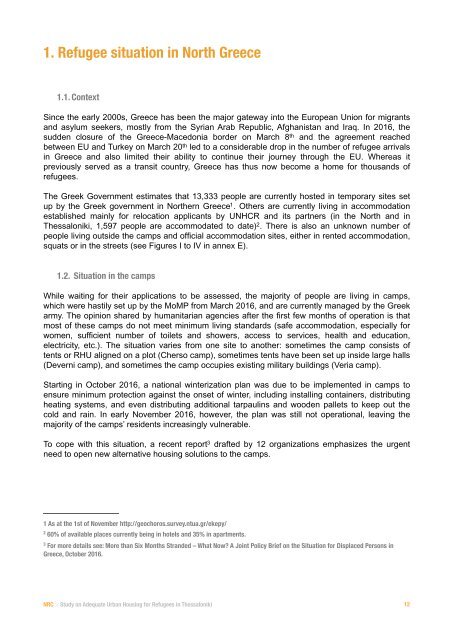STUDY ON ADEQUATE URBAN HOUSING FOR REFUGEES
adequate-housing-study-report-etc-18-11-2016-final
adequate-housing-study-report-etc-18-11-2016-final
Create successful ePaper yourself
Turn your PDF publications into a flip-book with our unique Google optimized e-Paper software.
1. Refugee situation in North Greece<br />
1.1. Context<br />
Since the early 2000s, Greece has been the major gateway into the European Union for migrants<br />
and asylum seekers, mostly from the Syrian Arab Republic, Afghanistan and Iraq. In 2016, the<br />
sudden closure of the Greece-Macedonia border on March 8 th and the agreement reached<br />
between EU and Turkey on March 20 th led to a considerable drop in the number of refugee arrivals<br />
in Greece and also limited their ability to continue their journey through the EU. Whereas it<br />
previously served as a transit country, Greece has thus now become a home for thousands of<br />
refugees.<br />
The Greek Government estimates that 13,333 people are currently hosted in temporary sites set<br />
up by the Greek government in Northern Greece<br />
1. Others are currently living in accommodation<br />
established mainly for relocation applicants by UNHCR and its partners (in the North and in<br />
Thessaloniki, 1,597 people are accommodated to date)<br />
2. There is also an unknown number of<br />
people living outside the camps and official accommodation sites, either in rented accommodation,<br />
squats or in the streets (see Figures I to IV in annex E).<br />
1.2. Situation in the camps<br />
While waiting for their applications to be assessed, the majority of people are living in camps,<br />
which were hastily set up by the MoMP from March 2016, and are currently managed by the Greek<br />
army. The opinion shared by humanitarian agencies after the first few months of operation is that<br />
most of these camps do not meet minimum living standards (safe accommodation, especially for<br />
women, sufficient number of toilets and showers, access to services, health and education,<br />
electricity, etc.). The situation varies from one site to another: sometimes the camp consists of<br />
tents or RHU aligned on a plot (Cherso camp), sometimes tents have been set up inside large halls<br />
(Deverni camp), and sometimes the camp occupies existing military buildings (Veria camp).<br />
Starting in October 2016, a national winterization plan was due to be implemented in camps to<br />
ensure minimum protection against the onset of winter, including installing containers, distributing<br />
heating systems, and even distributing additional tarpaulins and wooden pallets to keep out the<br />
cold and rain. In early November 2016, however, the plan was still not operational, leaving the<br />
majority of the camps’ residents increasingly vulnerable.<br />
To cope with this situation, a recent report<br />
3<br />
drafted by 12 organizations emphasizes the urgent<br />
need to open new alternative housing solutions to the camps.<br />
! 1 As at the 1st of November http://geochoros.survey.ntua.gr/ekepy/<br />
2<br />
60% of available places currently being in hotels and 35% in apartments.<br />
3<br />
For more details see: More than Six Months Stranded – What Now? A Joint Policy Brief on the Situation for Displaced Persons in<br />
Greece, October 2016.<br />
NRC > Study on Adequate Urban Housing for Refugees in Thessaloniki !12


